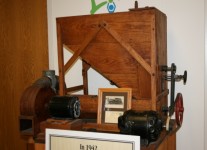A Look Back At The Wooden Seed Treater

If you’ve ever watched an old movie about World War II, you know that this was a conflict unlike the globe at ever seen. Not only was virtually every nation on the planet involved in the fighting, but this tended to spill over into the life of your average person. There were nightly blackouts in cities across the country, gasoline rationing and shortages of various materials being used in the war effort such as rubble and steel.
This latter material — carbon steel — presented something of a challenge for manufacturers of agricultural-based equipment. Among this group was Gustafson, Inc.
From its beginnings during the early 1900s, Gustafson had built its reputation on manufacturing many different products for growers and ag retailers, among them seed treaters. One of the most popular of these units was the Model H. Made of carbon steel, the Model H was used by small grain seed operators across the Midwest during the 1930s and 1940s.
The Need For Wood
In 1942, however, the company was faced with something of a crisis when it came to producing the Model H. Carbon steel was in high demand by the U.S. government to make weapons of war, so Gustafson couldn’t obtain any.
But instead of scrapping its Model H production for the duration of World War II, Gustafson re-designed the unit using wooden components.
The wooden Model H proved popular enough with customers until Gustafson was able to switch back to the carbon steel version at the end of World War II.
Today, one of the last remaining wooden Model Hs sits as a display piece in the Bayer SeedGrowth facility in Shapokee, MN (which purchased Gustafson in the early 2000s) — a testament to spirit of Classic IRON, albeit with a wooden heart.






